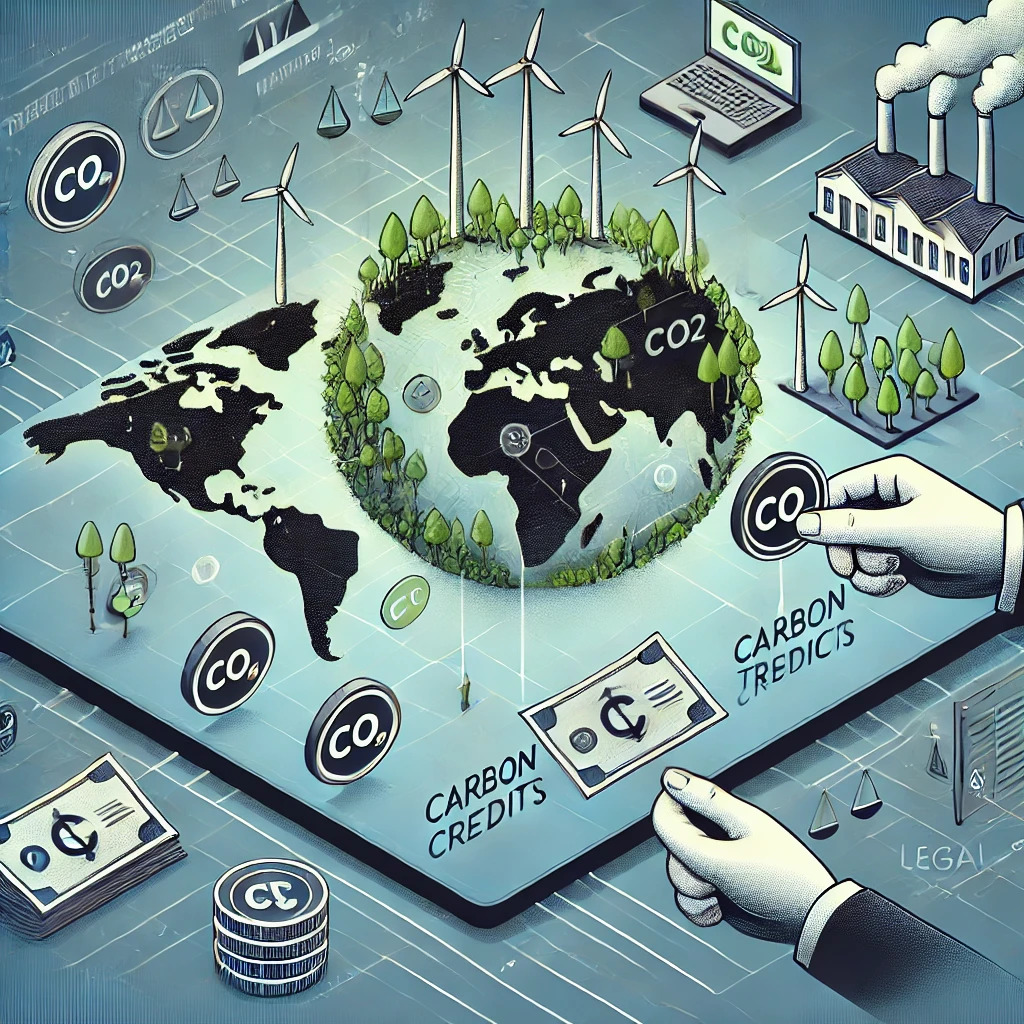View News
Carbon-Trading-and-Markets-How-to-Thrive-in-the-Legal-Complicatedness-of-Offsets-and-Schemes

Carbon Trading and Markets: How to Thrive in the Legal Complicatedness of Offsets and Schemes
~Sura Anjana Srimayi
INTRODUCTION
Trading schemes and markets for carbon are among the prominent tools that, through their action of pricing the carbon emission, have encouraged government agencies and corporate bodies to move towards decreasing environmental impacts. But the complex legal and economic structures that underpin carbon markets, such as the application of offsets, are full of pitfalls that need to be carefully avoided. Lets explores the complexities of carbon markets, their mechanisms, legal issues, and economic implications.
Carbon markets work on the "cap and trade" or "baseline and credit" systems in which actors are issued allowances or credits that are a measure of acceptable carbon emissions. The actors who are over the limit can buy allowances from those who emit less, providing a market mechanism for decreasing the aggregate emissions. Carbon offsets, however, are reductions or removals of greenhouse gases that occur through activities like reforestation or the development of renewable energy, enabling entities to offset their unavoidable emissions.
Why Carbon Markets? The Rationale for Emission Trading
- Cost-Effectiveness: Carbon markets enable emissions reductions to take place where they are cheapest, reducing the overall cost of climate change mitigation.
- Flexibility and Innovation: Carbon markets offer flexibility to companies to adopt the most cost-effective approaches to cutting emissions, encouraging technological innovation and investment in clean energy.
- Market-Driven Approach: Carbon markets use market forces to motivate emissions reductions, without the need for prescriptive regulation or government mandate.
- Revenue Generation: Carbon markets can generate revenue for governments and project developers, which can be used to support additional climate action.
Where Do Carbon Markets Exist? The Global and Regional Landscape
- National Emission Trading Schemes (ETS): Some countries like the European Union, China, and South Korea have national ETS covering certain sectors and industries.
- Regional and Sub-National ETS: Various regional and sub-national ETS are in place, including the Regional Greenhouse Gas Initiative (RGGI) in the United States and the Western Climate Initiative (WCI) in North America.
- Voluntary Carbon Markets: Voluntary carbon markets provide consumers and companies with the ability to buy carbon offsets to offset their emissions, frequently triggered by corporate social responsibility or consumer behavior.
- International Carbon Markets: The Paris Agreement creates an international carbon market cooperation framework aimed at enabling the transfer of mitigation results between nations.
How Do Carbon Markets Operate? The Mechanisms of Emission Trading
- Cap or Baseline: A cap or baseline is defined, limiting the allowed emissions by covered entities.
- Allowances or Credits: Allowances or credits are issued to covered entities, denoting their proportion of the cap or baseline.
- Trading: Parties are permitted to trade allowances or credits between themselves, purchasing or selling in accordance with their performance of emissions.
- Offsets: Organizations can buy carbon offsets to pay for their inevitable emissions, funding activities that prevent or remove greenhouse gases.
- Monitoring, Reporting, and Verification (MRV): Strong MRV systems are required to prove the quality and integrity of emissions information and offset activities.
Legal Complexities: Navigating the Regulatory Landscape
- Regulatory Uncertainty: The regulatory and legal environment for carbon markets is currently developing, which makes it uncertain for investors and businesses.
- Offset Integrity: Guaranteeing additionality, permanence, and the prevention of leakage in carbon offset projects is imperative to uphold market integrity and prevent greenwashing.
- International Cooperation: The Paris Agreement's international framework for cooperation on carbon markets necessitates complicated agreements and negotiations between nations.
- Compliance and Enforcement: Strong enforcement and compliance institutions are necessary to make sure entities comply with rules and regulations in the market.
- Liability and Dispute Resolution: Liability for emissions and settling disputes related to carbon market trade needs well-established legal frameworks.
Economic Implications: The Costs and Benefits of Carbon Trading
- Carbon Pricing: Carbon markets attach a price tag to carbon emissions, encouraging enterprises to minimize their environmental impact.
- Investment in Clean Technology: Carbon markets can trigger investment in clean technologies and renewable energy, generating economic growth and innovation.
- Competitiveness: Carbon pricing may impact the competitiveness of companies and sectors, making consideration of impacts very important.
- Revenue Generation: Carbon markets have the potential to raise revenue for governments and developers of projects that can be applied towards further action on climate change.
- Market Volatility: Prices for carbon may be volatile based on a number of variables including economic activity, policy measures, and advances in technology.
Legal Economic Example: Consider a case in which an offsets purchaser from an advanced country buys carbon offsets from a developing-country reforestation project. Afterwards, there is a legal controversy surrounding the additionality or the permanence of the project and its invalidation of the offsets.
In the example:
- Legal Uncertainty: The uncertainty of legal frameworks in place makes cross-border offset trading unclear for businesses and investors.
- Liability and Dispute Resolution: The conflict between parties across different jurisdictions is uncertain regarding liability for validating offsets as well as dispute resolution mechanisms between the parties.
- Reputational Risk: The party that buys the offsets has reputational risk in case the offsets are discovered to be invalid.
- Market Integrity: The controversy can debase market integrity and erode investor confidence in carbon offset projects.
This scenario identifies the legal challenges involved with cross-border offset trading and the requirement for effective legal frameworks that support market integrity and investor trust.
CONLUSION
Carbon markets and trading schemes have the ability to make a huge contribution to mitigating climate change. Yet, their efficacy hinges on overcoming legal intricacies and maintaining market integrity. Through the creation of sound legal frameworks, encouraging transparency, and facilitating international collaboration, we can construct sound and fair carbon markets that motivate emissions reductions while building a sustainable future. Strong MRV systems, and greater transparency must be achieved in order to enhance confidence in such markets.
"Unlock the Potential of Legal Expertise with LegalMantra.net - Your Trusted Legal Consultancy Partner”
Disclaimer: Every effort has been made to avoid errors or omissions in this material in spite of this, errors may creep in. Any mistake, error or discrepancy noted may be brought to our notice which shall be taken care of in the next edition In no event the author shall be liable for any direct indirect, special or incidental damage resulting from or arising out of or in connection with the use of this information Many sources have been considered including Newspapers, Journals, Bare Acts, Case Materials , Charted Secretary, Research Papers etc.

